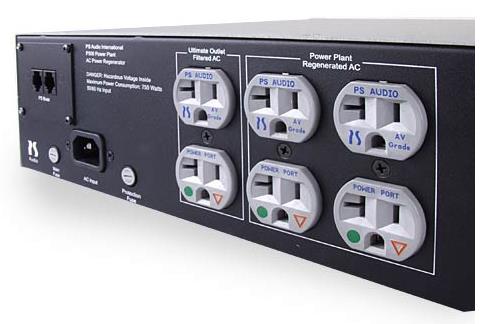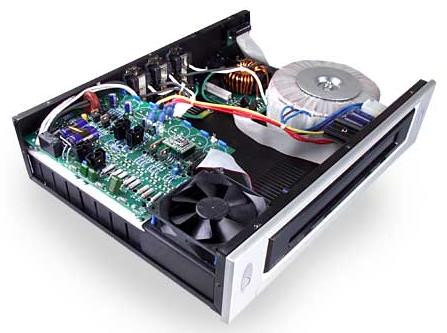Introduction
Some time ago, I reviewed the PS Audio
P1200 Power Plant. It has served me for more than 3 years now, without
any problems. It is an invaluable part of my home theater and test facility.
The PS Audio Power Plants are in the category of AC
Line Conditioners or Power Conditioners, but PS Audio calls them AC
Regenerators. The reason for this is that conventional line conditioners
filter the incoming AC, attempting to remove harmonics and high frequency
noise that plague all of our home AC lines. Filters are not perfect, so the
noise and harmonics are not totally removed. They also typically do not
regulate the voltage, nor do they supply balanced AC. Power Plants do both.
The Power Plant converts the incoming AC to DC, then
converts this back to AC at whatever frequency (50 Hz or 60 Hz and voltage
(110 volts to 125 volts) that you wish. Converting it to DC removes all the
noise and harmonics. A DSP chip is used to modulate the DC to not only just
garden variety 50 Hz or 60 Hz sine waves, but what they call "MultiWave",
which contains a combination of frequencies that benefit various types of
equipment.
The Design
The original P1200 is very large and very heavy (150
pounds). It is a hard item to find room for, but it is so important to me, I
make room for it. Since that time, PS Audio has revised their designs,
bringing the power rating of the models to 1000 watts in the case of the
P1000 (which replaces the older P1200) and 500 watts in the case of the P500
(which replaces the older P600). While my P1200 gets pretty warm, I found
the P500 not to get very warm at all, so obviously, the efficiency has
improved. In fact, this was one of the original criticisms of the P600 and
P1200: they input a lot more electricity than they output.
The P500 is a lot smaller and lighter than the P600
too. This is part of the improved efficiency (notwithstanding the 100 watt
difference between the two products). While the P600 might not fit on some
shelves, the P500 slid easily into my laboratory equipment rack.
The rear panel of the P500 has six double AC sockets
(PS Audio's "Power Ports"). They are laboratory grade sockets. Four of them
supply the regenerated AC, at whatever voltage and frequency you have set
the unit at, while two of the sockets supply "Filtered AC", which is the
wall socket voltage passed through some internal filters. So, you might
connect your sources (CD player and processor) to the regenerated AC
outputs, and your power amplifiers to the filtered outputs, since 500 watts
might not be enough to supply the power amps. What I have found though, is
that, using the meter on the front of the Power Plants to indicate the power
output, the amount of wattage that is required seems to be much lower than I
would have thought. For example, with the P1200, and supplying power to my
projector, DVD player, Receiver, and several large subwoofers, the draw was
only 900 watts even when the system was playing loud. So, the P500 might
actually be enough to supply all your sources plus a modestly powered
receiver. You just have to try your system out and see. If too much power is
drawn, the P500 shuts down.

Below is a photo of the inside of the chassis. You can
see the power transformer on the right, and the cooling fan at the bottom
left. It came on occasionally during use, but is very quiet.

As I mentioned, the front panel reads out the wattage
being delivered. It also reads out the voltage setting, which is adjustable
between 110 volts and 125 volts (for the North American version). By using
the buttons on the front panel, you set the voltage. You can have the panel
read out the percentage of available wattage that is being used too. Once I
set the voltage, which is regulated to within 1 volt regardless of the power
demands, I set the readout to display the wattage being used and left it
there.
The 500 watt output rating is the peak output. It can
deliver 300 watts continuous to solid state components and 250 watts
continuous to tube components.
Because the 60 Hz is being generated by DSP, it is easy
to have it generate other waveforms as well. This is where the MultiWave
feature comes in. A number of waveforms are available on the Power Plants,
including some that have various harmonics inserted. One is specially
designed for tube products. The "Auto" setting lets the P500 compute the
best waveform based on the components connected to it.
They don't recommend using any of the special
waveforms if the component has a fan in it, such as in some power amplifiers
and projectors. In this case, they suggest sticking with sine waves, which
is what comes out of the wall. For my system, although I have tubed
components, some of the components have fans, so I used the regular 60 Hz
sine wave all the time. I set the voltage to 115 volts.
Why have waveforms with harmonics if the Power Plants
are designed to remove harmonics in the first place? The answer is that the
MultiWave DSP inserts specific harmonics that can improve the efficiency of
some component power supplies, as opposed to the random harmonics that are
present in AC wall socket power.
In Use
I tested the P500 with numerous components in our
facilities. Using a McCormack Audio transport and DAC, plus a Balanced Audio
Technology VK-5i stereo tube preamplifier, only 200 watts were drawn, well
within the P500's power capabilities. I also tested it with a mass market
universal player (Yamaha). I did not connect any of our power amplifiers
(Balanced Audio Technology and McIntosh) because they are all much too
powerful.
What I found is that the P500, like the P1200, benefits
mass market components more than high-end components, but all
components benefit to some degree. I suppose this is because the mass market
products don't have the massive power supplies that the high-end products
do, so noise in the lines gets through more with the mass market products.
The effect was one of reduced glare and edginess in the
sound, which could indeed be a result of less harmonics and high frequency
noise getting into the audio signal path. The harmonics and high frequency
noise can "beat" with the audio signal, causing distortion, even if the
noise is beyond the audible band. Since one of the audio benefits of high
resolution audio - DVD-A and SACD - is a smoother sound, the Power
Plant can help get the most out of them. That is what I found when I put a Classé Audio SACD-2 player into the system.
You might wonder why the need for a product that is
basically an audio amplifier that outputs at a fixed frequency. It has a
power supply too, just as your regular amplifier does. Well, the answer lies
firstly in the fact that the power supply on the Power Plant acts as an additional
filter. Secondly, since the Power Plant does not have to output power at
audio frequencies above a few hundred Hertz, low-pass filters can be in the
circuit to remove any noise that otherwise might slip through. In your main
amplifier, those filters cannot be there, since you want 20 Hz - 20 kHz and
beyond to make its way to the speakers. Third, the output of the Power Plant
has a very low impedance, lower than the wall socket AC, so components will
have maximum efficiency in drawing power.
Conclusions
The PS Audio Power Plants are one of a kind products.
Instead of filtering the AC, they reconstruct it from scratch. This is
unique to PS Audio.
The result is a noticeably smoother sound, particularly
with mass market components, but also heard with high-end components which
may not be able to remove every bit of grunge that is in the AC power from
the wall.
It's an expensive product, but if you buy one, you
might find, as I did, that it will become one of the most useful items in
your home theater or audio system.
- John E. Johnson, Jr. -